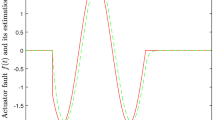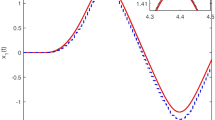Abstract
In this study, a novel robust fault diagnosis scheme is developed for a class of nonlinear systems when both fault and disturbance are considered. The proposed scheme includes both component and sensor fault with nonlinear system that transferred to nonlinear Takagi-Sugeno (T-S) model. It considers a larger category of nonlinear system when fuzzification is used for only nonlinear distribution matrices. In fact the proposed method covers nonlinear systems could not transform to linear T-S model. This paper studies the problem of robust fault diagnosis based on two fuzzy nonlinear observers, the first one is a fuzzy nonlinear unknown input observer (FNUIO) and the other is a fuzzy nonlinear Luenberger observer (FNLO). This approach decouples the faulty subsystem from the rest of the system through a series of transformations. Then, the objective is to design FNUIO to guarantee the asymptotic stability of the error dynamic using the Lyapunov method; meanwhile, FNLO is designed for faulty subsystem to generate fuzzy residual signal based on a quadratic Lyapunov function and some matrices inequality convexification techniques. FNUIO affects only the fault free subsystem and completely removes any unknown inputs such as disturbances when residual signal is generated by FNLO is affected by component or sensor fault. This novelty and using nonlinear system in T-S model make the proposed method extremely effective from last decade literature. Sufficient conditions are established in order to guarantee the convergence of the state estimation error. Thus, a residual generator is determined on the basis of LMI conditions such that the estimation error is completely sensitive to fault vector and insensitive to the unknown inputs. Finally, an numerical example is given to show the highly effectiveness of the proposed fault diagnosis scheme.
Similar content being viewed by others
References
J. Gertler, Fault Detection and Diagnosis in Engineering Systems, CRC press, Marcel Dekker, 1998.
J. Chen and R. J. Patton, Robust Model-based Fault Diagnosis for Dynamic Systems, Springer US, vol. 3, 2012.
I. Hwang, S. Kim, Y. Kim, and C. E. Seah, “A survey of fault detection, isolation, and reconfiguration methods,” IEEE Transactions on Control Systems Technology, vol. 18, no. 3, pp. 636–653, 2010.
Z. Gao, C. Cecati, and S. X. Ding, “A survey of fault diagnosis and fault-tolerant techniques, part i: Fault diagnosis with model-based and signal-based approaches,” IEEE Transactions on Industrial Electronics, vol. 62, no. 6, pp. 3757–3767, 2015.
Z. Gao, C. Cecati, and S. X. Ding, “A survey of fault diagnosis and fault-tolerant techniques, part ii: Fault diagnosis with knowledge-based and hybrid/active approaches,” IEEE Transactions on Industrial Electronics, vol. 62, pp. 6 pp. 3768-3774, 2015.
T. Boukra, A. Lebaroud, and G. Clerc, “Statistical and neural-network approaches for the classification of induction machine faults using the ambiguity plane representation,” IEEE Transactions on Industrial Electronics, vol. 60, no. 9, pp. 4034–4042, 2013.
S. Sahin, M. Tolun, and R. Hassanpour, “Hybrid expert systems: A survey of current approaches and applications,” Expert Systems with Applications, vol. 39, no. 4, pp. 4609–4617, 2012. [click]
R. Raoufi, H. J. Marquez, and A. S. I. Zinober, “H∞ sliding mode observers for uncertain nonlinear lipschitz systems with fault estimation synthesis,” International Journal of Robust and Nonlinear Control, vol. 20, no. 16, pp. 1785–1801, 2010. [click]
J. Yang, F. Zhu, X. Wang, and X. Bu, “Robust sliding-mode observer-based sensor fault estimation, actuator fault detection and isolation for uncertain nonlinear systems,” International Journal of Control, Automation and Systems, vol. 13, no. 5, pp. 1037–1046, 2015. [click]
M. Ghaniee and M. A. Shoorehdeli, “Fault detection of nonlinear systems by parity relations,” Proc. of 2nd International Conference on Control, Instrumentation and Automation (ICCIA), pp. 519–523, Dec 2011.
S. Yin, X. Yang, and H. R. Karimi, “Data-driven adaptive observer for fault diagnosis,” Mathematical Problems in Engineering pp. 21, Aug 2012.
X. Zhang, M. M. Polycarpou, and T. Parisini, “Fault diagnosis of a class of nonlinear uncertain systems with lipschitz nonlinearities using adaptive estimation,” Automatica, vol. 46, no. 2, pp. 290–299, 2010. [click]
A. Nagy-Kiss, G. Schutz, and J. Ragot, “Parameter estimation for uncertain systems based on fault diagnosis using Takagi??Sugeno model,” ISA Transactions, vol. 56, no. 65-74, 2015. [click]
S. J. Yoo, “Fault detection and accommodation of a class of nonlinear systems with unknown multiple time-delayed faults,” Automatica, vol. 50, no. 1, pp. 255–261, 2014. [click]
M. L. Corradini, A. Cristofaro, R. Giambò, and S. Pettinari, “A lyapunov-based diagnosis signal for fault detection robust tracking problem of a class of sampled-data systems,” CDC-ECE, pp. 3730–3735, 2011.
S. Wang, J. Feng, and H. Zhang, “Robust fault tolerant control for a class of networked control systems with state delay and stochastic actuator failures,” International Journal of Adaptive Control and Signal Processing, vol. 28, no. 9, pp. 798–811, 2014. [click]
Y.-L. Wang, T.-B. Wang, and Q.-L. Han, “Fault detection filter design for data reconstruction-based continuoustime networked control systems,” Information Sciences, vol. 328 pp. 577–594, 2016. [click]
X. Su, P. Shi, L. Wu, and Y. D. Song, “Fault detection filtering for nonlinear switched stochastic systems,” IEEE Transactions on Automatic Control vol. 61, no. 5, pp. 1310–1315, May 2016.
O. Nelles, Nonlinear System Identification: From Classical Approaches to Neural Networks and Fuzzy Models, Springer-Verlag Berlin Heidelberg, 2001.
G. Feng, Analysis and Synthesis of Fuzzy Control Systems: A Model-based Approach, CRC Press, 2010.
F. Farivar and M. A. Shoorehdeli, “Fault tolerant synchronization of chaotic heavy symmetric gyroscope systems versus external disturbances via Lyapunov rule-based fuzzy control,” ISA transactions, vol. 51, no. 1, pp. 50–64, 2012. [click]
H. Guo, J. Qiu, H. Tian, and H. Gao, “Fault detection of discrete-time T–S fuzzy affine systems based on piecewise lyapunov functions,” Journal of the Franklin Institute vol. 351, no. 7, pp. 3633–3650, 2014. [click]
D. Ichalal, B. Marx, J. Ragot, and D. Maquin, “Fault detection, isolation and estimation for TakagiSugeno nonlinear systems,” Journal of the Franklin Institute vol. 351, no. 7, pp. 3651–3676, 2014. [click]
Q. Shen, B. Jiang, and P. Shi, “Adaptive fault diagnosis for t-s fuzzy systems with sensor faults and system performance analysis,” Fuzzy Systems, IEEE Transactions, vol. 22, no. 2, pp. 274–285, 2014.
A. Akhenak, M. Chadli, J. Ragot, and D. Maquin, “Fault detection and isolation using sliding mode observer for uncertain takagi-sugeno fuzzy model,” Control and Automation, 2008 16th Mediterranean Conference on, IEEE, pp. 286–291, 2008.
K. Zhang, B. Jiang, and V. Cocquempot, “Fuzzy unknown input observer-based robust fault estimation design for discrete-time fuzzy systems,” Signal Processing, vol. 128, pp. 40–47, 2016. [click]
X.-J. Li and G.-H. Yang, “Fault detection in finite frequency domain for takagi-sugeno fuzzy systems with sensor faults,” IEEE Transactions on Cybernetics, vol. 44, no. 8, pp. 1446–1458, 2014.
X.-J. Li and G.-H. Yang, “Fault detection for t-s fuzzy systems with unknown membership functions,” IEEE Transactions on Fuzzy Systems, vol. 22, no. 1, pp. 139–152, 2014.
J. Dong, Y. Wang, and G. H. Yang, “Control synthesis of continuous-time t-s fuzzy systems with local nonlinear models,” IEEE Transactions on Systems, Man, and Cybernetics, Part B (Cybernetics), vol. 39, no. 5, pp. 1245–1258, Oct 2009.
D. Jiuxiang and Y. Guang-Hong, “H∞ dynamic output feedback control for t-s fuzzy systems with local nonlinear models,” Control Conference (CCC), 2012 31st Chinese, pp. 3443–3448, 2012.
M. A. J. Koopaee and V. J. Majd, “Controller design with constraint on control input and output for T-S fuzzy systems with nonlinear local model,” Proc. of 23rd Iranian Conference on Electrical Engineering, pp. 876–881, May 2015.
M. Aldeen and R. Sharma, “Estimation of states, faults and unknown disturbances in non-linear systems,” International Journal of Control, vol. 81, no. 8, pp. 1195–1201, 2008. [click]
X.-G. Yan and C. Edwards, “Nonlinear robust fault reconstruction and estimation using a sliding mode observer,” Automatica, vol. 43, no. 9, pp. 1605–1614, 2007. [click]
R. Raoufi and H. Marquezz, “Simultaneous sensor and actuator fault reconstruction and diagnosis using generalized sliding mode observers,” Proc. of American Control Conference (ACC), IEEE, pp. 7016–7021, 2010.
J. Zarei and E. Shokri, “Robust sensor fault detection based on nonlinear unknown input observer,” Measurement, vol. 48 pp. 355–367, 2014. [click]
M. Witczak, “Unknown input observers and filters, in: Fault Diagnosis and Fault-Tolerant Control Strategies for Non-Linear Systems,” Lecture Notes in Electrical Engineering, Springer International Publishing, vol. 266, pp. 19–56, 2014. [click]
T. Sedighi, A. Koshkouei, and K. J. Burnham, “Nonlinear unknown input observer design for nonlinear systems: A new method,” Preceedings of the 18th IFAC World Congress, Elsevier, New York, NY, USA, pp. 11067–11072, 2011.
W. Chen and M. Saif, “Unknown input observer design for a class of nonlinear systems: an lmi approach,” Proc. of American Control Conference, IEEE, pp. 5-, 2006.
W. Chen and M. Saif, “Fuzzy nonlinear unknown input observer design with fault diagnosis applications,” Journal of Vibration and Control, vol. 16, no. 3, pp. 377–401, 2010.
D. Saoudi, M. Chadli, N. B. Braeik, “Robust estimation design for unknown inputs fuzzy bilinear models,” Application to Faults Diagnosis, in: Complex System Modelling and Control Through Intelligent Soft Computations, Springer, pp. 655–685, 2015.
R. Rajamani, “Observers for lipschitz nonlinear systems,” Automatic Control, IEEE Transactions, vol. 43, no. 3, pp. 397–401, 1998.
A. Isidori, Nonlinear Control Systems, Springer Science & Business Media, vol. 1, 1995.
K. K. Hassan, Nonlinear Systems, Prentice Hall Inc., 2002.
P. B. Jackson, Overview of Missile Flight Control Systems, Johns Hopkins APL technical digest, vol. 29, no. 1, pp. 9–24, 2010.
S.-F. C. Albert and N. E. Leonard, “Fin failure compensation for an unmanned underwater vehicle,” Proc. 11th Int. Symp. on Unmanned Untethered Submersible Technology, Citeseer, pp. 10, 1999.
A. Alessandri, “Observer design for nonlinear systems by using input-to-state stability,” Proc. of 43rd IEEE Conference on Decision and Control (CDC), vol. 4, pp. 3892–3897, 2004.
Author information
Authors and Affiliations
Corresponding author
Additional information
Recommended by Associate Editor Guang-Hong Yang under the direction of Editor Euntai Kim.
S. Hamideh Sedigh Ziyabari received the B.S. degree in Electronic Engineering from Guilan University in 2008 and M.Sc degree in Control Engineering from the Sahand University of Technology, Tabriz, Iran in 2010. In Sep.2012, She joined as a PhD student to Control and System of Science and Research branch of Azad University of Tehran. Her research interests include Fault detection and estimation, Nonlinear control, Predictive control and their application to control of the world.
Mahdi Aliyari Shoorehdeli received his B.S. degree in Electronic Engineering in 2001, his M.Sc and Ph.D. degrees in Control Engineering in 2003 and 2008 in Control Engineering from K. N. Toosi University of Technology, Tehran repetitively. He has been with the Mechatronics Department of K. N. Toosi University of Technology, Tehran, Iran since 2010. His research interests include Fault Diagnosis, System Identification and Alarm Management.
Rights and permissions
About this article
Cite this article
Ziyabari, S.H.S., Shoorehdeli, M.A. Robust fault diagnosis scheme in a class of nonlinear system based on UIO and fuzzy residual. Int. J. Control Autom. Syst. 15, 1145–1154 (2017). https://doi.org/10.1007/s12555-016-0145-0
Received:
Revised:
Accepted:
Published:
Issue Date:
DOI: https://doi.org/10.1007/s12555-016-0145-0




